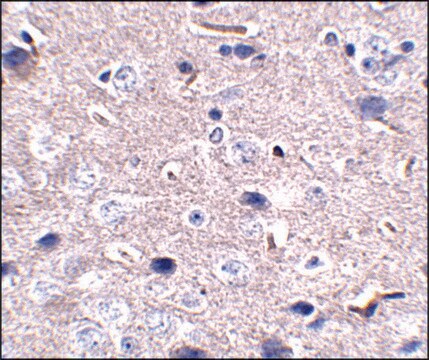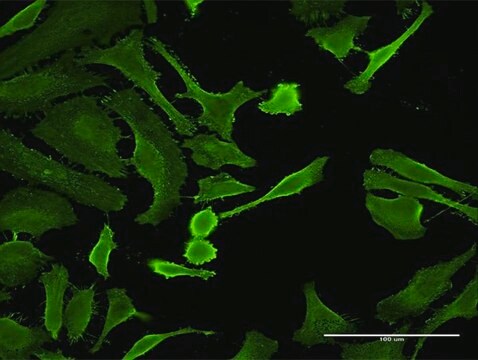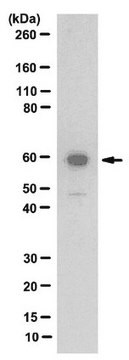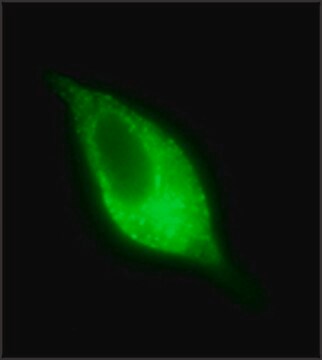Alle Fotos(1)
Wichtige Dokumente
C9979
Monoclonal Anti-CD152 antibody produced in mouse
~1 mg/mL, clone AS32, purified immunoglobulin, buffered aqueous solution
Synonym(e):
Anti-CTLA-4
Anmeldenzur Ansicht organisationsspezifischer und vertraglich vereinbarter Preise
Alle Fotos(1)
About This Item
Empfohlene Produkte
Biologische Quelle
mouse
Qualitätsniveau
Konjugat
unconjugated
Antikörperform
purified immunoglobulin
Antikörper-Produkttyp
primary antibodies
Klon
AS32, monoclonal
Form
buffered aqueous solution
Speziesreaktivität
human
Konzentration
~1 mg/mL
Methode(n)
neutralization: suitable
western blot: suitable
Isotyp
IgG1
UniProt-Hinterlegungsnummer
Versandbedingung
wet ice
Lagertemp.
2-8°C
Posttranslationale Modifikation Target
unmodified
Angaben zum Gen
human ... CTLA4(1493)
Allgemeine Beschreibung
CD152 is structurally similar to CD28 and is a member of the immunoglobin (Ig) gene superfamily. The gene encoding human CD152 is present on chromosone 2. It is composed of a single Ig V-like extracellular domain, a transmembrnne domain, and an intracellular domain. It is mainly expressed by cytotoxic T lymphocytes and the level of expression is activation-dependent.
Immunogen
recombinant extracellular domain of human CD152.
Anwendung
Monoclonal Anti-CD152 antibody produced in mouse is suitable for western blotting and for neutralization studies, where this antibody has been shown to block the interaction of soluble human CD152 with human CD80.
Biochem./physiol. Wirkung
CD152 and CD28 together with their ligands constitute one of the dominant co-stimulatory pathways that regulate T- and B-cell responses. CD152 acts as a co-stimulatory molecule in eliciting T cell help during antigen presentation and functions as a negative regulator of T cell activation.
Zielbeschreibung
CD152, a cell surface glycoprotein, is one of two ligands (the other is CD28) for CD80 (B7-1) and CD86 (B7-2). This interaction appears to function as a negative regulator to T cell activation. CD152 is transiently expressed on activated T cells.
Physikalische Form
Solution in 0.01 M phosphate buffered saline, pH 7.4, containing 0.08% sodium azide.
Angaben zur Herstellung
Prepared from tissue culture supernatant, purified using protein G.
Haftungsausschluss
Unless otherwise stated in our catalog or other company documentation accompanying the product(s), our products are intended for research use only and are not to be used for any other purpose, which includes but is not limited to, unauthorized commercial uses, in vitro diagnostic uses, ex vivo or in vivo therapeutic uses or any type of consumption or application to humans or animals.
Sie haben nicht das passende Produkt gefunden?
Probieren Sie unser Produkt-Auswahlhilfe. aus.
Lagerklassenschlüssel
10 - Combustible liquids
WGK
WGK 2
Flammpunkt (°F)
Not applicable
Flammpunkt (°C)
Not applicable
Hier finden Sie alle aktuellen Versionen:
Besitzen Sie dieses Produkt bereits?
In der Dokumentenbibliothek finden Sie die Dokumentation zu den Produkten, die Sie kürzlich erworben haben.
Yasuhiro Shimojima et al.
Modern rheumatology, 27(1), 102-109 (2016-05-05)
We investigated the characteristics of circulating T-helper (Th) cells and CD4 Peripheral blood samples were obtained from 14 patients with PAN. Nine patients having granulomatosis with polyangiitis (GPA) and 11 healthy individuals (HC) were enrolled as controls. Th cells and
T Lindsten et al.
Journal of immunology (Baltimore, Md. : 1950), 151(7), 3489-3499 (1993-10-01)
CTLA-4 is an adhesion receptor expressed on activated T cells. The amino acid sequence of CTLA-4 is related to CD28, and although the function of CTLA-4 remains unknown, it shares several features with CD28, including a common counter-receptor, B7, that
N J Karandikar et al.
The Journal of experimental medicine, 184(2), 783-788 (1996-08-01)
CTLA-4, a CD28 homologue expressed on activated T cells, binds with high affinity to the CD28 ligands, B7-1 (CD80) and B7-2 (CD86). This study was designed to examine the role of CTLA-4 in regulating autoimmune disease. Murine relapsing-remitting experimental autoimmune
M Murakami et al.
Proceedings of the National Academy of Sciences of the United States of America, 93(15), 7838-7842 (1996-07-23)
To determine whether alternative cytotoxic T lymphocyte-associated protein 4 (CTLA4) binding proteins exist on B cells, we constructed (i) mCTLA4hIgG consisting of the extracellular region of a mouse CTLA4 molecule and the Fc portion of a human IgG1 molecule and
Danbee Ha et al.
Proceedings of the National Academy of Sciences of the United States of America, 116(2), 609-618 (2018-12-28)
Anti-CTLA-4 mAb is efficacious in enhancing tumor immunity in humans. CTLA-4 is expressed by conventional T cells upon activation and by naturally occurring FOXP3+CD4+ Treg cells constitutively, raising a question of how anti-CTLA-4 mAb can differentially control these functionally opposing
Unser Team von Wissenschaftlern verfügt über Erfahrung in allen Forschungsbereichen einschließlich Life Science, Materialwissenschaften, chemischer Synthese, Chromatographie, Analytik und vielen mehr..
Setzen Sie sich mit dem technischen Dienst in Verbindung.







